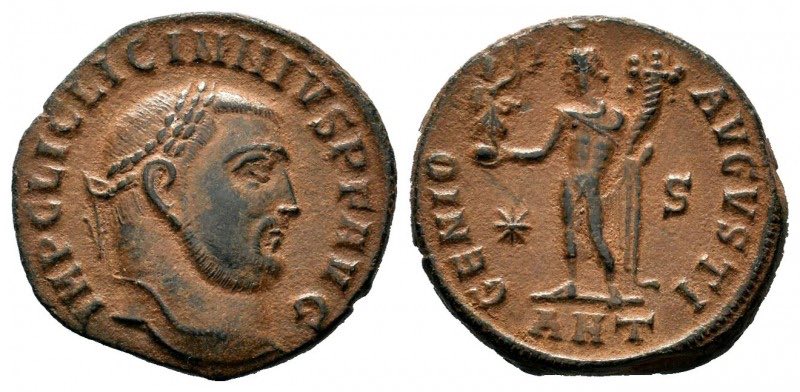 Licinius, Roman emperor, 308-324. Varieties of the GENIO AVGVSTI follis.
Licinius, Roman emperor, 308-324. Varieties of the GENIO AVGVSTI follis.
Licinius came to power in an unusual way; he was appointed. In 308 Galerius, the eastern Augustus, called the Conference at Carnuntum (a Roman legionary fortress on the Danube River 25 miles east of Vienna) to straighten out who was to be ruling in the west. Galerius arranged to have Licinius promoted directly to western Augustus (He had not been Caesar).
That was the one decision of that conference that actually had some effect. The other decisions of the conference that were intended to reduce the number of western rulers (by making Maximian retire again and declaring Maxentius a "public enemy") were ignored. It took Constantine and his army, not a conference, to remove them in 310 and 312, respectively. (For more of the history, see below.)
The coin above to the right: GENIO AVGVSTI for Licinius as Augustus, with Genius holding Victory on globe and cornucopia. Other varieties are below. Licinius's name is spelled with two N's (IMP C LIC LICINNIVS PF AVG), although it is commonly spelled with one.
21-20 mm. 4.69 grams. Struck 311-312. Fieldmarks * S, mintmark ANT. RIC Antioch 162a. This issue is shared with Maximinus II (Antioch was in his territory) and Constantine.
GENIO AVGVSTI. The GENIO AVGVSTI type with Genius standing left resembles the very common GENIO POPVLI ROMANI type. It comes in six varieties, including
• the basic "Genius standing" type (the next two coins),
• a flaming altar at the feet of Genius,
• an eagle at the feet of Genius (not illustrated here),
• Genius holding Victory on globe instead of a patera,
• Genius holding the head of Serapis, and
• Genius holding the head of Sol.
It is common for the earliest coins of an emperor to have his name in a longer, more complete, form and later coins to shorten his name, once he has become known as emperor. The first coin has a remarkably long name for Licinius.
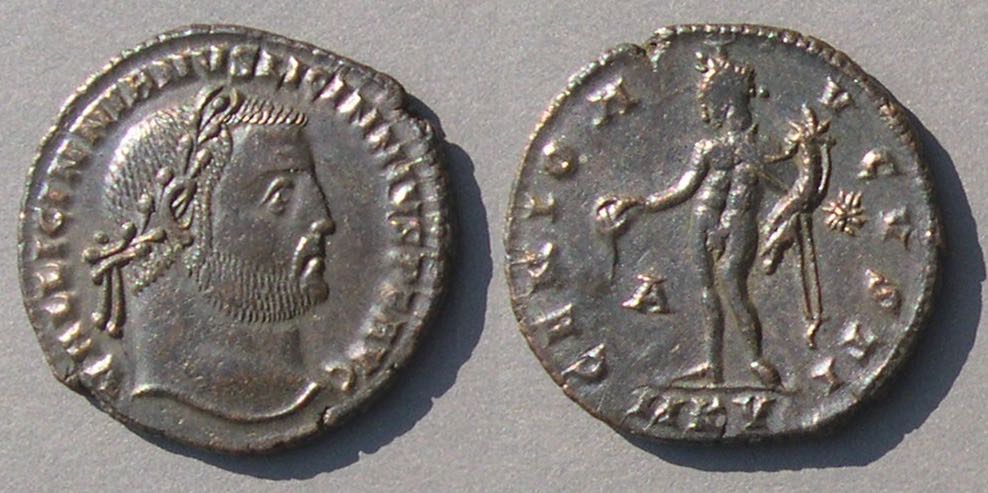 Licinius, with a long obverse legend.
Licinius, with a long obverse legend.
25 mm.
c. 309-310
VAL LICINNIANVS LICINNIVS PF AVG
This long full name for Licinius is used only at Cyzicus and only for the first two groups for Licinius.
Also, Licinius is spelled with "NN" which is not the normal spelling.
GENIO AVGVSTI
Genius standing left holding patera and cornucopia, just like on the earlier GENIO POPVLI ROMANI folles.
A *
MKV
RIC VI Cyzicus 54.
[Click the images to enlarge them.]
The next example is similar, but with a shorter obverse legend and from Thessalonica, with "Licinius" with one "N" as we spell it.
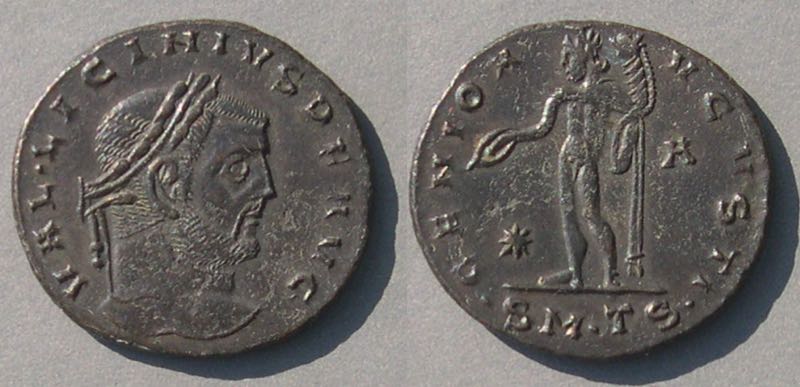 Licinius, with a shorter obverse legend
Licinius, with a shorter obverse legend
25-24 mm.
c. Dec. 308 - May 311
VAL•LICINIVS PF AVG
GENIO AVGVSTI as above
* A
•SM•TS•
RIC Thessalonica 30bA
The next example has a flaming altar.

Licinius
21 mm.
IMP C VAL LICIN LICINIVS PF AVG
GENIO AVGVSTI as above, with flaming altar to left
Δ
SMN
RIC Nicomedia 71a
The next example has Genius holding Victory on a globe. [This repeats the coin at the top of the page.]

Licinius
21-20 mm. 4.69 grams.
311-312
IMP C LIC LICINIVS PF AVG
GENIO AVGVSTI
Genius standing left holding Victory on globe and cornucopia
* S
ANT
RIC Antioch 162a
This example has Genius holding the head of Serapis.
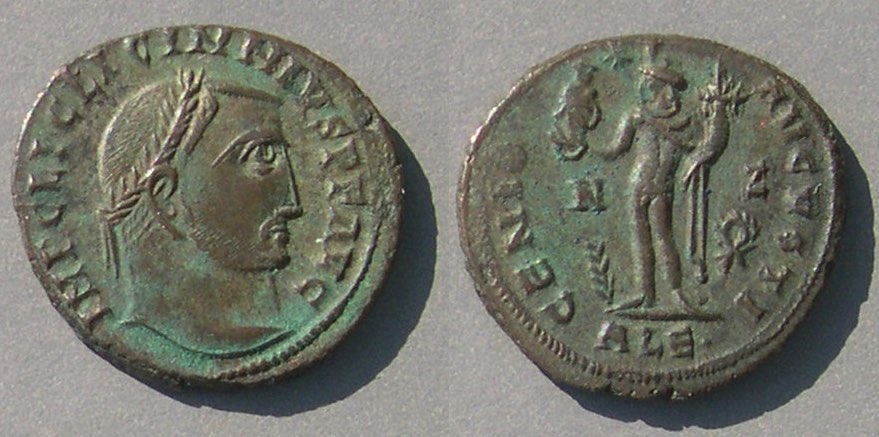
Licinius
22 mm.
IMP C LIC LICINNIVS PF AVG
GENIO AVGVSTI
Genius standing left, modius on head, holding head of Serapis (with modius on head) and cornucopia
N Z
palm wreath
ALE•
RIC Alexandria 162a
GENIO AVGVSTI was also issued for Licinius with Genius holding the head of Sol.

Licinius
21 mm.
IMP C LIC LICINNIVS PF AVG
GENIO AVGVSTI
Genius standing left, modius on head, holding head of Sol (radiate) and cornucopia
✳ H
ANT
RIC Antioch 164a "C, 312"
Here is one in the name of Maximinus II from the same issue, shared with Licinius at Antioch.
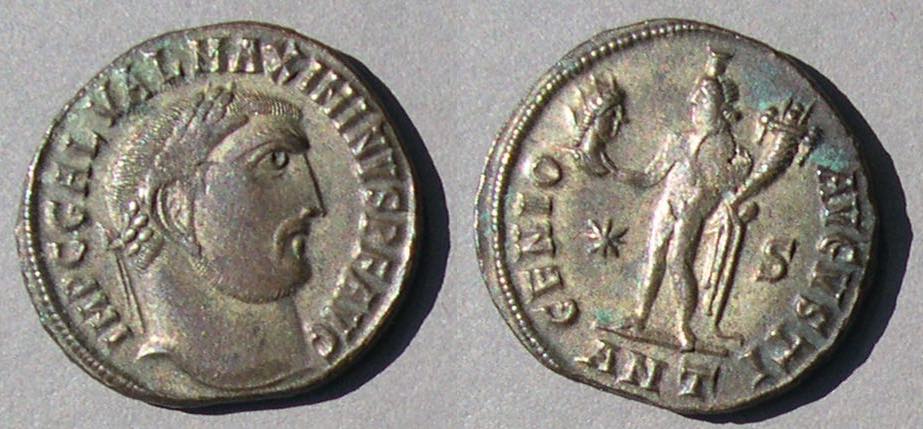 Maximinus II
Maximinus II
21 mm. 4.54 grams
IMP C GAL VAL MAXIMINVS PF AVG
GENIO AVGVSTI
Genius standing left, modius on head, holding radiate head of Sol and cornucopia
✳ S
ANT
RIC VI Antioch 164b "312"
History. The tetrarchy. In 293 Diocletian instituted a system for imperial succession known as the tetrarchy, "four rulers." Two Augusti and two Caesars ruled simultaneously with the intention that Augusti would eventually be replaced by the Caesars and the newly promoted Caesars replaced by new men as the new Caesars. The First Tetrarchy lasted until 305 when there was an orderly transition to the Second Tetrarchy.
The breakdown of the tetrarchal system. By 308 the system had broken down--there were too many claimants to power in the west. Constantine assumed power in 306 as Caesar upon the death of his father, the Augustus Constantius, whereupon the previous Caesar, Severus II, became Augustus. So far, so good. However, later in 306 Maxentius, son of Maximian who had been western Augustus under the First Tetrarchy, usurped power in Rome when the current western Augustus, Severus II was away in the north. Maximian, who had been forced to retire in 305, gladly came out of retirement to join his son. So, in late 306 there were two additional rulers claiming to be Augusti, making six active rulers, not four. (Severus II, Constantine, Maximian, and Maxentius in the west, and Galerius and Maximinus II in the east.) Severus II was killed in 307 after trying and failing to retake Rome. That left Constantine, Maximian, and Maxentius located in the west and all claiming the title Augustus.
The decision of Carnuntum to make Licinius Augustus in the west forced the four western rulers to decide who ruled where by the old tried-and-true method, with armies. Maximian was killed in 310. Galerius died of disease in 311 and Maximinus II took his eastern territory. Maxentius was defeated and killed by Constantine in 312. Maximinus II died of natural causes in 313 and Licinius inherited the east. Collectors know most of his coins are of eastern types. In 324 Licinius lost the second of two civil wars with Constantine, after which Constantine was sole Augustus over the whole Roman empire.
Go to the page with links to pages on the tetrarchies.
Go to the main Table of Contents page for this educational site.
 Licinius, Roman emperor, 308-324. Varieties of the GENIO AVGVSTI follis.
Licinius, Roman emperor, 308-324. Varieties of the GENIO AVGVSTI follis. 




